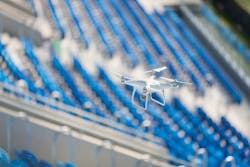Drones may be one of the biggest security risks to U.S. stadiums. We recently dodged a bullet as a single drone dropped its payload over two sold-out San Francisco Bay Area stadiums hosting NFL football games. Fortunately, no one was hurt by anti-media leaflets falling into the stands.
But the next time something like this happens the payload may be chemicals, biological agents or explosives. The potential for injuries and loss of life is very real. Many stadium operators understand the potential risks they face, but are uncertain about what protocols to put in place or what technologies to purchase to help mitigate the threat. In most cases, stadiums have no funded strategy to address this new risk. It may take something very bad happening for people to wake up and take action.
There are already numerous federal, state and local laws limiting where drones are permitted to fly. Drones were not permitted within 500 feet of one of the stadiums involved in the recent incident. But as with any law, only the good guys pay attention.
What’s needed is technology capable of quickly detecting an impending drone attack and protocols for saving lives. Fortunately, those tools already exist. Highly effective sensors spot drones anywhere within a several-mile radius. The technology reads the control signals letting stadium security see how many and what type of drones are in the area and accurately pinpoint the pilot’s location.
Detecting and Mitigating the Threat
The first thing I tell stadium operators is we’ve got to know the degree of threat around their facility. This requires measuring the actual frequently of drones flying nearby. The use of unmanned aerial systems (UAS) sensors at the stadium will detect drone traffic with a virtual geo-fence. Monitor drone activity for two to three weeks. I guarantee the number of flights will be amazing.
Next, it’s important to get a sense of what are passive versus malicious threats. A single drone flown in a nearby park isn’t likely to be a major concern, however; it’s still a liability as the drone could crash and cause injuries. Keep an eye on anything entering stadium airspace.
But if sensors show a single pilot flying five, 10 or more drones at high speed directly at the stadium, you’re likely facing a malicious attack. What do you do? This is where well-planned and rehearsed protocols come into play.
With the drones still 10 miles out, notify the security team and use available technology to assess the situation. As the drones get even closer, leverage security cameras to get “eyes on the targets.” Use high-resolution cameras with zoom lenses to track the drones and their path. At a designated distance (pre-determined by the security team), issue an alert to the security team and all other employees. Let first responders know what’s happening and provide information on the pilot’s location. Get players off the field and fans evacuated or under protective cover.
You also must maintain control of the situation. A mass panic can result in more injuries as fans stampede for the exits. Every employee, from concession sellers to the stadium manager, needs to have a well-defined role that has been practiced frequently. For example, a stadium custodian may be responsible for evacuating a single section of seats. At this point the goal is to save lives and minimize injury. You aren’t likely to stop the attack.
Remember, the time to be vigilant isn’t limited to game days. A drone can spray seats with chemicals days before fans arrive.
Legal Considerations
Technologies for shooting down drones and/or jamming their signals exist and are used in other countries. But most anti-drone solutions are illegal in the U.S. The Federal Aviation Administration has taken a strong stance against shooting down drones fearing the process could cause even more problems. And the Federal Communications Commission has opposed jamming drone control signals due to possible interruption of frequencies used by mobile phones and first responder communications.
Drones are a prime example of legislation trailing reality. Several industry experts are eagerly waiting for the FAA, Department of Homeland Security and the Department of Defense to align and approve advanced technology that can block signals without impacting other communications. I’m confident changes will eventually be made. Those of us serving on the FAA Drone Advisory Committee’s Subcommittee are working to propose a wide range of recommendations that safely integrate UAS into the national airspace with the right balance of regulations.
Being Proactive is Paramount
Drone detection and response technology can be expensive. That’s why many stadium operators are reluctant to make an upfront investment. They hope if they wait long enough the ultimate solution will be found or decrease in cost. Meanwhile, they’re banking that nothing bad will happen at their facility. It reminds me of the response many school administrators had to active shooters 15 to 20 years ago.
How we integrate drones into our airspace is complex. We’re making progress, but still have a long way to go. We don’t want to scare people so they no longer come to stadiums. But we need to put some fear into stadium operators who have the responsibility of keeping people safe while they enjoy stadium activities.
About the Author:
Nancy Ford is the owner of Security 101 – Salt Lake City. She is also a member of the Federal Aviation Administration’s Drone Advisory Committee Subcommittee, charged with identifying and proposing actions for the FAA on how to best facilitate issues affecting the efficiency and safety of integrating unmanned aircraft systems into the nation’s airspace.



